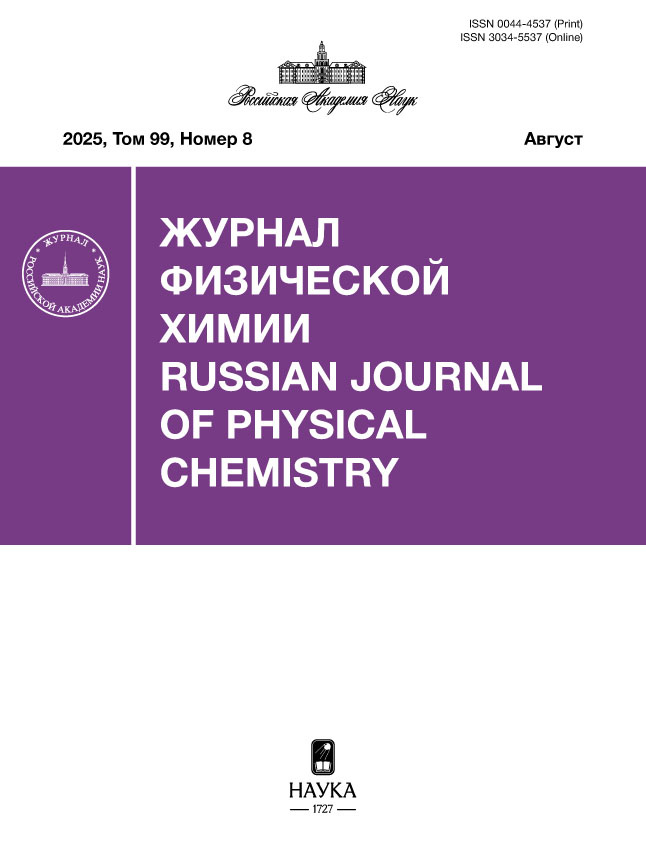HEAT CAPACITY AND THERMODYNAMIC PROPERTIES OF LA3TAO7
- Autores: Gagarin P.G.1, Guskov A.V.1, Guskov V.N.1, Tyurin A.V.1, Gavrichev K.S.1
-
Afiliações:
- Federal State Budgetary Institution of Science N. S. Kurnakov Institute of General and Inorganic Chemistry, Russian Academy of Sciences
- Edição: Volume 99, Nº 8 (2025)
- Páginas: 1163-1169
- Seção: CHEMICAL THERMODYNAMICS AND THERMOCHEMISTRY
- ##submission.dateSubmitted##: 06.11.2025
- ##submission.datePublished##: 15.08.2025
- URL: https://consilium.orscience.ru/0044-4537/article/view/695887
- DOI: https://doi.org/10.7868/S3034553725080056
- ID: 695887
Citar
Texto integral
Resumo
Palavras-chave
Sobre autores
P. Gagarin
Federal State Budgetary Institution of Science N. S. Kurnakov Institute of General and Inorganic Chemistry, Russian Academy of Sciences
Email: gagarin@igic.ras.ru
119991, Moscow, Russia
A. Guskov
Federal State Budgetary Institution of Science N. S. Kurnakov Institute of General and Inorganic Chemistry, Russian Academy of Sciences119991, Moscow, Russia
V. Guskov
Federal State Budgetary Institution of Science N. S. Kurnakov Institute of General and Inorganic Chemistry, Russian Academy of Sciences119991, Moscow, Russia
A. Tyurin
Federal State Budgetary Institution of Science N. S. Kurnakov Institute of General and Inorganic Chemistry, Russian Academy of Sciences119991, Moscow, Russia
K. Gavrichev
Federal State Budgetary Institution of Science N. S. Kurnakov Institute of General and Inorganic Chemistry, Russian Academy of Sciences119991, Moscow, Russia
Bibliografia
- Kumar V., Balasubramanian K. // Prog. Org. Coat. 2016. V. 90. P. 54. https://doi.org/10.1016/j.porgcoat.2015.09.019
- Hardwicke C.U., Lau Y.C. // J. Therm. Spray. Technol. 2013. V. 22. P. 564. https://doi.org/10.1007/s11666-013-9904-0
- Wang L., Wang Y., Sun X.G., et al. // Ceram. Inter. 2012. V. 38. P. 3595. https://doi.org/10.1016/j.ceramint.2011.12.076
- Mohan P., Yuan B., Patterson T., et al. // J. Am. Ceram. Soc. 2007. V. 90. P. 3601. https://doi.org/10.1111/j.1551-2916.2007.01941.x
- Fergus J.W. // Metall. Mater. Trans. 2014. V. 6. P. 118. https://doi.org/10.1007/s40553-014-0012-y
- Angle J.P., Steppan J.J., Thompson P.M. // J. Eur. Ceram. Soc. 2014. V. 34. P. 4327. https://doi.org/10.1016/j.jeurceramsoc.2014.06.020
- Limarga A.M., Shian S., Leckie R.M. // J. Eur. Ceram. Soc. 2014. V. 34. P. 3085. https://doi.org/10.1016/j.jeurceramsoc.2014.03.013
- Wang L., Wang Y., Sun X.G. // Mater. Des. 2012. V. 35. P. 505. https://doi.org/10.1016/j.matdes.2011.09.031
- Padture N.P. // Science 2002. V. 296. № 5566. P. 280. https://doi.org/10.1126/science.1068609
- Arseniev P.A., Glushkova V.B., Evdokimov A.A., et al. Compounds of rare-earth elements. Zirconates, Hafnates, Niobates, Tantalates, Antimonates. Nauka, Moscow, 1985. 261 p. [Арсеньев П.А., Глушкова В.Б., Евдокимов А.А. и др. Соединения редкоземельных элементов. Цирконаты, гафнаты, ниобаты, танталаты, антимонаты. М.: Наука, 1985. 261 c.]
- Сиротинкин В.П., Евдокимов А.А., Трунов В.К. // ЖНХ. 1982. Т. 27. № 7. С. 1648–1651. [Sirotinkin V.P., Evdokimov A.A., Trunov V.K. // Russ. J. Inorg. Chem. 1982. V. 27. № 7. P. 1648]
- Haoming Z., Yan F., Xiaoge C. et al. // Ceram. Int. 2017. V. 43. № 1. P. 755. https://doi.org/10.1016/j.ceramint.2016.10.005
- Subramani T., Navrotsky A. // Inorg. Chem. 2019. V. 58. P. 16126. https://doi.org/10.1021/acs.inorgchem.9b02675.
- Tyurin A.V., Khoroshilov A.V., Guskov V.N., et al. // Russ. J. Inorg. Chem. 2018. V. 63. P. 1599. 10.1134/S0036023618120215' target='_blank'>https://doi: 10.1134/S0036023618120215 [Тюрин А.В., Хорошилов А.В., Гуськов В.Н., и др. // ЖНХ. 2018. Т. 63. С. 1583–1588. https://doi.org/10.1134/S0044457X18120218]
- Ryumin M.A., Nikoforova G.E., Tyurin A.V. et al. // Inorg. Mater. 2020. V. 56. P. 102. 10.1134/S00201685200101148' target='_blank'>https://doi: 10.1134/S00201685200101148 [Рюмин М.А., Никифорова Г.Е., Тюрин А.В., и др. // Неорган. материалы. 2020. Т. 56. С. 97–104.]
- https://www.qdusa.com/products/ppms.html
- Prohaska T., Irrgeher J., Benefield J. et al. // Pure Appl. Chem. 2022. V. 94. № 5. P. 573. https://doi.org/10.1515/pac-2019-0603]
- Konings R.J.M., Beneš O., Kovács A., et al. // JPCRD. 2014. V. 43. № 1. https://doi.org/10.1063/1.4825256
- Jacob K.T., Shekhar C., Waseda Y. // J. Chem. Thermodynamics. 2009. V. 41. P. 748. https://doi.org/10.1016/j.jct.2008.12.006
- Voskov A.L., Kutsenok I.B., Voronin G.F. // Calphad. 2018. V. 61. P. 50. https://doi.org/10.1016/j.calphad.2018.02.001
- Voronin G.F., Kutsenok I.B. // J. Chem. Eng. Data. 2013. V. 58. P. 2083. https://doi.org/10.1021/je400316m
- Maier C.G., Kelley K.K. // J. Am. Chem. Soc. 1932. V. 54. P. 3243. https://doi.org/10.1021/ja01347a029
- Глушко В.П. Термические константы веществ. Справочник. М., 1965–1982. [Glushko V.P. Thermal constants of substances. Reference book. Moscow, 1965–1982]
- Barin I., Platzki G. Thermochemical Data of Pure Substances. 3rd Edition. Weinheim: VCh, 2003. P. 1117.
- Forbes T.Z., Nyman M., Rodriguez M.A., et al. // J. Solid State Chem. 2010. V. 183 P. 2516. https://doi.org/10.1016/j.jssc.2010.08.024.
Arquivos suplementares










